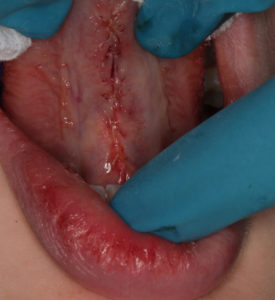Tongue tie surgery can be life altering; it can promote a young person’s growth and development. It can also help reduce the severity of snoring and sleep apnea in adults. Tongue tie surgery goes by several different names, which have different technical nuances: frenotomy, frenectomy, frenuloplasty (in order of invasiveness).
The Definition
Ankyloglossia is the medical term for tongue tie — a condition that can be as mild as slightly limiting a tongue’s range of motion to causing speech and swallowing pathologies, underdevelopment of the mouth, and potentially sleep apnea and TMJ problems. Depending on the type of tongue tie, a person may need simple stretching techniques to significant releasing surgeries.
The taut band of tissue just under the tongue may attach high up into the tip of the tongue, causing a small heart shape to form when the tongue is maximally extended upward. At the other end, the tissue may attach deep down into the floor of the mouth (like a class 3 or 4 posterior tongue tie), to the front to middle portion of the floor of the mouth (class a class 2 anterior tongue tie), or to the gum tissue just behind the lower front teeth itself (a class 1 tongue tie).
The Problem
The problem with a tongue tie from a growth and development standpoint is that the muscles attaching the tongue to the neck and the jaw become overly tightened from disuse. The styloglossus muscle attaches to the temporal bone of the TMJ (Temporo-Mandibular Joint) and when enough tension is placed on that muscle, the fossa (“socket”) that the condyle (“ball”) sits in can become rotated. This puts an unfavorable torque on the TMJ. Furthermore, the low lying position of the tongue against the bottom jaw tends to limit normal neck curvature and add to a forward head posture position. These conditions are highly correlated in patients with both sleep apnea and TMJ dysfunction.
A low lying tongue position also contributes to poor muscle tone of the tongue itself, as well as to the muscles lining the soft palate. This low tone contributes to snoring. Snoring is caused by vibration of these soft tissues and is evidence of a reduction of air going into the lungs.
The Solution
The solution to managing a tongue tie is always multi-fold. Training the tongue into the correct position is necessary both prior to and after a lingual frenectomy (also known as tongue-tie release). That training comes via Orofacial Myology (Myofunctional) Therapy http://caugheydds.com/orofacial-myology/.
Sometimes before the Orofacial Myology (Myofunctional) Therapy has a chance of being effective, the patient’s palate needs to be expanded enough for the tongue to physically fit into the palate. In our office, we most often choose a form of the ALF (Alternative Light Wire Functional Appliance) to do that palate expansion, because its sleek design does not prohibit the tongue from being able to inhabit the palate (roof of mouth) as soon as the palate is ready to receive it. To learn more about the ALF and other Functional Growth Appliances go to http://caugheydds.com/category/functional-growth-appliances/.
A low lying tongue position also contributes to poor muscle tone of the tongue itself, as well as to the muscles lining the soft palate. This low tone contributes to snoring. Snoring is caused by vibration of these soft tissues and is evidence of a reduction of air going into the lungs. To see more about Snoring and its Bad Big Brother Sleep Apnea, see http://caugheydds.com/snoring-sleep-apnea-solutions/.


When tongue tie surgery (frenectomy/frenuloplasty) is recommended is when key benefits outweigh the potential risk of the surgery. The procedure is performed for both adults and children, but the growth and development benefits are largely limited to a still-growing child. Patients with the best results are frequently committed to stretching and exercising the tongue muscle following the surgery.
When the tongue tie surgery is done in combination with orofacial myology therapy, it is then called a functional frenuloplasty. You can see examples of our mentor Dr. Soroush Zaghi MD on this video:
